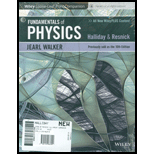
To select correct options:
On which of the following does the interval between adjacent energy levels in the highest occupied band of a metal depend?
(a) the material of which the sample is made
(b) the size of the sample
(c) the position of the level in the band
(d) the temperature of the sample
(e) the Fermi energy of the metal
Answer to Problem 1Q
Solution:
The interval between adjacent energy levels in the highest occupied band of a metal depend on
(b) the size of the sample
(c) the position of the level in the band
(d) the temperature of the sample.
Explanation of Solution
Explanations
1) Concept
An isolated atom can exist in only a discrete set of energy levels. As atoms come together to form a solid, the levels of the individual atoms merge to form the energy bands. An energy band is made up of an enormous number of very closely spaced levels.
The density of occupied states No(E) is given by the product of two quantities P(E) and N(E).
No(E) = P(E) x N(E)
P(E) is the probability of occupancy. And N(E) is the number of energy levels per unit volume of the sample per unit energy.
P(E) =
2) Given:
Five option to select from to answer the question regarding adjacent energy levels.
3) Equations
P(E) =
4) Calculations
The highest occupied band in a metal is the
The interval between adjacent energy levels in a conduction band will depend on N(E) and the number of electrons – which means it will depend on the size of the sample. This implies that option (b) is correct.
Probability of occupancy P(E), and N(E) both depend on energy E – that is the position of the energy level in the band. This implies that option (c) is correct.
In addition, we see that the energy levels are dependent on temperature T. Also thermal expansion and contraction of metals, will increase or decrease the electron energy overlaps, and hence the adjacent energy levels.
Conclusion
The free electrons in a metal fill up the conduction band. But all energy levels including adjacent energy levels are closely spaced levels due to the Pauli Exclusion Principle.
Want to see more full solutions like this?
Chapter 41 Solutions
FUND.OF PHYSICS(LL)-PRINT COMP-W/ACCESS
- Pls help ASAParrow_forward14. A boy is out walking his dog. From his house, he walks 30 m North, then 23 m East, then 120 cm South, then 95 m West, and finally 10 m East. Draw a diagram showing the path that the boy walked, his total displacement, and then determine the magnitude and direction of his total displacement.arrow_forwardPls help ASAParrow_forward
- 12. A motorboat traveling 6 m/s, West encounters a water current travelling 3.5 m/s, South. a) Draw a vector diagram showing the resultant velocity, then determine the resultant velocity of the motorboat. b) If the width of the river is 112 m wide, then how much time does it take for the boat to travel shore to shore? c) What distance downstream does the boat reach the opposite shore?arrow_forwardLake Erie contains roughly 4.00⋅10114.00⋅1011 m3 of water. Assume the density of this water is 1000. kg/m3 and the specific heat of water is 4186 J/kg˚C. It takes 2.31x10^19 J of energy to raise the temperature of that volume of water from 12.0 °C to 25.8 ˚C. An electric power plant can produce about 1110 MW. How many years would it take to supply this amount of energy by using the 1110 MW from an electric power plant?arrow_forwardPls help ASAParrow_forward
- Pls help ASAParrow_forwardm m $2° 15. A truck is stopped at a red light. Once the light turns green, the truck accelerates forward at 1.75- that same instant, a car moving with a constant speed of 50 — passes the truck. a) How many seconds will it take for the truck to catch up to the car? S b) How many metres will the truck travel before it catches up to the car? Atarrow_forwardPls help ASAParrow_forward
 Modern PhysicsPhysicsISBN:9781111794378Author:Raymond A. Serway, Clement J. Moses, Curt A. MoyerPublisher:Cengage Learning
Modern PhysicsPhysicsISBN:9781111794378Author:Raymond A. Serway, Clement J. Moses, Curt A. MoyerPublisher:Cengage Learning Physics for Scientists and Engineers with Modern ...PhysicsISBN:9781337553292Author:Raymond A. Serway, John W. JewettPublisher:Cengage Learning
Physics for Scientists and Engineers with Modern ...PhysicsISBN:9781337553292Author:Raymond A. Serway, John W. JewettPublisher:Cengage Learning University Physics Volume 3PhysicsISBN:9781938168185Author:William Moebs, Jeff SannyPublisher:OpenStax
University Physics Volume 3PhysicsISBN:9781938168185Author:William Moebs, Jeff SannyPublisher:OpenStax Glencoe Physics: Principles and Problems, Student...PhysicsISBN:9780078807213Author:Paul W. ZitzewitzPublisher:Glencoe/McGraw-Hill
Glencoe Physics: Principles and Problems, Student...PhysicsISBN:9780078807213Author:Paul W. ZitzewitzPublisher:Glencoe/McGraw-Hill Principles of Physics: A Calculus-Based TextPhysicsISBN:9781133104261Author:Raymond A. Serway, John W. JewettPublisher:Cengage Learning
Principles of Physics: A Calculus-Based TextPhysicsISBN:9781133104261Author:Raymond A. Serway, John W. JewettPublisher:Cengage Learning





